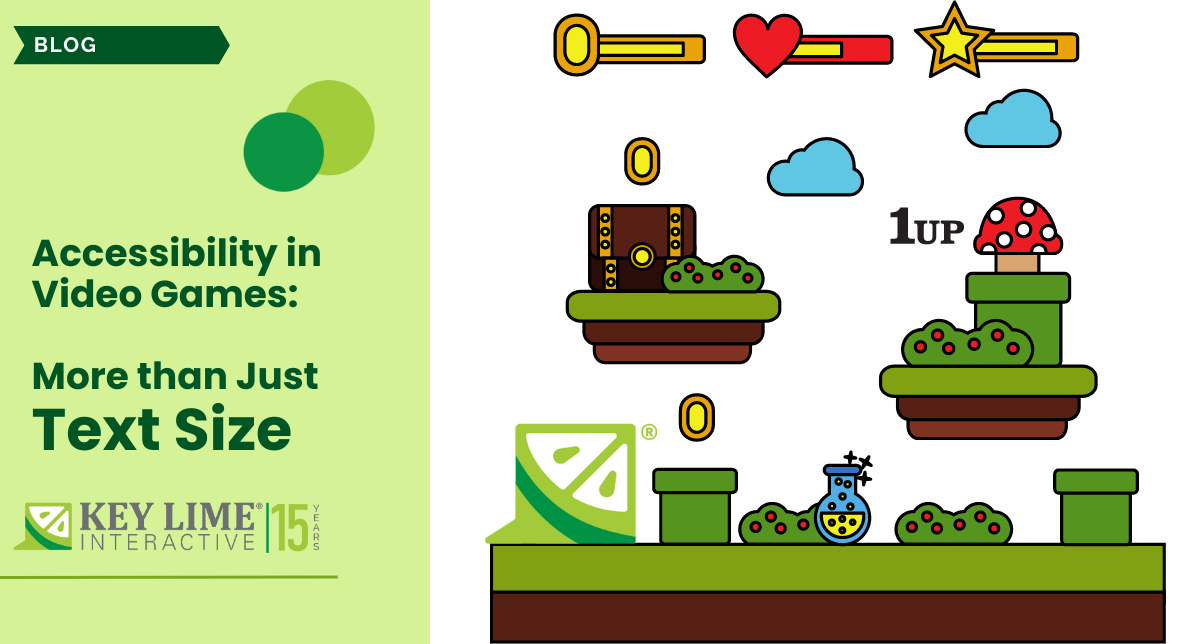
In terms of implementing accessibility, video games have several unique dimensions to interact with accessible designs due to the interactive and often narrative nature of video games. In addition to adding features that are clearly designed to enable play by any player – like adjusting the text size in the game and a visual outline to make important characters on screen more visible – video games provide the opportunity to incorporate accessible designs as part of the game experience itself.
Especially in recent years, overt accessibility features and settings have become increasingly frequent even in major, well-known video games, while resourceful game designers and developers have often incorporated designs that allow their games to be more accessible within the gameplay mechanics itself.
Notable accessibility settings in games
Several major releases have provided notable accessibility features and settings to accommodate disabled users. This seems to be a recent focus on video games. While games historically have had settings to adjust certain visual aspects, they are often limited to specific visual and auditory elements provided by the game’s setting – screen brightness, text sizes, resolution, subtitles, volume). They could leave out settings that could potentially benefit players with different needs, such as color blindness or limited fine motor control.
However, several recent major games have received a notable collection of in-game settings to provide more extensive accessibility in both visual and audio changes, as well as changes to make gameplay easier. For example, God of War, by Santa Monica Studio, was initially released on the PlayStation 4 in 2018, followed by a PC release in 2022 and a sequel, God of War: Ragnarök, for PS4 in 2022. The 2018 release featured a number of settings to control the interface, adjust the volume, change the game difficulty, and remap the controller. These changed what in-game actions that pressing a button on a game controller would do. However, both the God of War PC release and God of War: Ragnarök boast many accessibility options for players to adjust visual elements of the game interface, such as subtitle highlight, subtitle text color, and icon size. Ragnarök also provided settings to adjust gameplay elements, such as holding a button to fulfill in-game actions that by default required repeated button presses, to make the active experience of playing God of War more accessible. In fact, God of War: Ragnarök advertises “over 70 accessibility features” as well as accessibility presets to help players get started on customizing the game to their needs.
The two God of War games were not the only recent major game titles to feature an expanded suite of accessibility options. From Insomnia Studio’s Ratchet and Clank: a Rift Apart (2021), Marvel’s Spiderman (2018); Spiderman: Miles Morales (2020), and Spiderman Remastered (2022), to Naughty Dog’s Last of Us Part II (2020) and Part I (a 2022 remake of the original 2013 game), these high budget, popular games all feature a large number of accessibility options to adjust the audio, visual, and motor aspects of their games. In particular, the Last of Us Part II included a set of notable visual aid settings that applied high-contrast highlights to characters, enemies, and useful objects in the game.
The Last of Part II’s high-contrast visual aid options. Source: Naughty Dog
The above examples have one characteristic in common: they were originally (or currently exclusively) released on Sony’s PlayStation systems. However, these are far from the only major game releases with a suite of accessibility options. For example, EA’s Jedi Survivor, 2023, also features a large suite of accessibility features, and Microsoft’s Xbox has created an innovative Adaptive Controller to make the physical act of playing games more accessible.
Providing accessibility within the narrative and gameplay experience
In addition to accessibility settings that enable gameplay, games provide an opportunity for accessibility to be included in the experience of gameplay itself. The most common accessibility feature of this kind could be considered a game’s ability to adjust difficulty levels. The same game set to different difficulty levels can offer a more accessible experience. An easy difficulty level might allow the player to breeze through a roleplaying game, thoroughly enjoying the power fantasy. On the other hand, playing the same game on a hard difficulty level might require mechanical skill, mental focus, and repeated practice. Having the option of adjusting difficulty levels allows a player to adjust the overall gameplay to suit their particular preferences and choose the experience best suited for their capabilities.
Many roleplaying games have recognized the benefits of simply telling a story without a challenge and offered “story mode” or “assist mode,” removing some or most gameplay impediments and allowing players to witness the game’s events. Story modes enable a wider range of players to experience a game’s narrative, worldbuilding, and atmosphere, regardless of their physical abilities, skill level, available time, or attention span.
Deus Ex: Human Revolution. Source:Eidos Montreal, 2011
Celeste. Source: Maddy Makes Games, 2018
Instead of distinct difficulty options, some games approach accessibility by creating game mechanics that can make difficult challenges in a game accessible in a creative way, whether intentionally or not. For many players, fighting games as a genre can be difficult or intimidating. Traditional fighting games such as Street Fighter 6 (Capcom, 2023) or Tekken 7 (Bandai Namco Entertainment, 2017) require players to remember a long list of moves for each character, input the controller inputs quickly and precisely, and know not only their favorite character’s moves but those of other characters in the game.
Your Only Move Is Hustle (Ivy Sly, 2023), on the other hand, takes away the need to memorize the complex novelists of typical fighting games. In YOMI Hustle, players simply take turns choosing the moves their fighters will take in the duel from a list on screen and see the duel play out. Since the available moves are already visible, players of YOMI Hustle have no need to memorize a list of complicated controller inputs to start learning the game. This interesting approach to a fighting game can allow more players to enjoy the moment-to-moment decision-making in a typical fighting game without needing lightning-fast reflexes or pixel-perfect handling of a controller.
Your Only Move Is Hustle. Source: Ivy Sly, 2023
Final words, for now
Accessibility features have become an important part of video games, enabling more players to enjoy an interactive experience that might have previously been unavailable due to mental, knowledge, or physical limitations that can be daunting to overcome.
The process of creating and testing accessibility features or experiences could involve interested users and proactively ensure the accessibility of a new game. Key Lime Interactive researchers are a group of professionals interested in accessibility in technology, media, and entertainment. Please contact us if you want to understand how new technologies and user experience may affect your next project.
Additional Sources and further reading
A Growth of Accessibility in Video Games | DO-IT (washington.edu)
The Curb-Cut Effect (ssir.org)
Accessibility - The Curb Cut Effect - Extra Credits - YouTube
The Last of Us Part II - Accessibility (US) (playstation.com)
The Last of Us 2 goes beyond accessibility and difficulty levels - Polygon
Naughty Dog explains The Last of Us Part II’s ambitious accessibility features - The Verge
Sony wants its studios to "explore new and innovative ways" for accessibility (caniplaythat.com)
Accessibility and Player Choice in Dead Space (Electronic Arts, 2023 Remake)









Comments
Add Comment